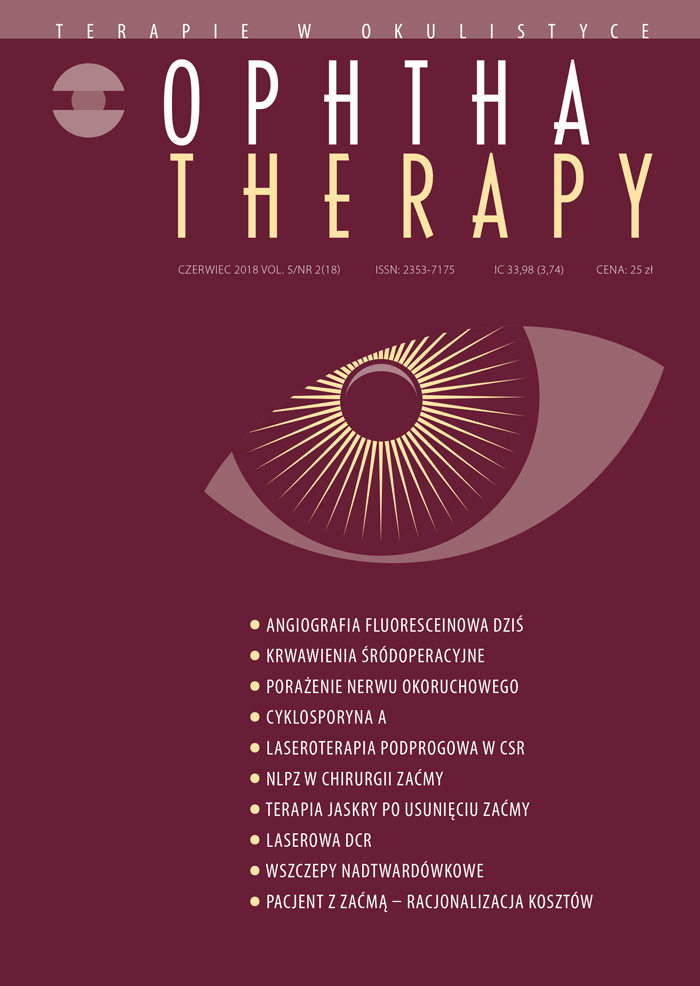Porażenie nerwu okoruchowego w przebiegu tętniaka tętnicy szyjnej wewnętrznej – opis przypadku
##plugins.themes.bootstrap3.article.main##
Abstrakt
Autorzy prezentują przypadek 48-letniej kobiety, u której wystąpiły niespecyficzne bóle głowy z następczym opadnięciem powieki, ograniczeniem ruchomości, poszerzeniem źrenicy w prawym oku oraz dwojeniem obrazu. Pacjentka dotychczas nie chorowała. W wywiadzie rodzinnym odnotowano śmierć ojca i siostry w młodym wieku z nieznanej przyczyny. W badaniu neurologicznym i okulistycznym ujawniono porażenie nerwu okoruchowego prawego. Badania tomografii komputerowej oraz angiografii rezonansu magnetycznego potwierdziły obecność tętniaka tętnicy szyjnej wewnętrznej prawej. U pacjentki w trybie pilnym przeprowadzono zabieg endowaskularny – embolizację tętniaka z użyciem coili. Autorzy dokonują przeglądu literatury w zakresie porażenia nerwu okoruchowego oraz tętniaków wewnątrzczaszkowych.
Pobrania
##plugins.themes.bootstrap3.article.details##

Utwór dostępny jest na licencji Creative Commons Uznanie autorstwa – Użycie niekomercyjne – Bez utworów zależnych 4.0 Międzynarodowe.
Copyright: © Medical Education sp. z o.o. License allowing third parties to copy and redistribute the material in any medium or format and to remix, transform, and build upon the material, provided the original work is properly cited and states its license.
Address reprint requests to: Medical Education, Marcin Kuźma (marcin.kuzma@mededu.pl)
Bibliografia
2. Kline LB, Foroozan R. Neuro-ophthalmology review manual. Wyd. 7, Slack New York 2013: 90.
3. Liu G, Volpe N, Galetta S. Neuro-ophthalmology: diagnosis and management. Wyd. 2, Elsevier Inc Saunders 2010: 512.
4. Brown RD Jr, Broderick JP. Unruptured intracranial aneurysms: epidemiology, natural history, management options, and familial screening. Lancet Neurol. 2014; 13(4): 393-404.
5. Ajiboye N, Chalouhi N, Starke RM et al. Unruptured Cerebral Aneurysms: Evaluation and Management. ScientificWorldJournal. 2015; 2015: 954954.
6. Chen X, Liu Y, Tong H et al. Meta-analysis of computed tomography angiography versus magnetic resonance angiography for intracranial aneurysm. Medicine (Baltimore). 2018; 97(20): e10771.
7. Kański J, Bowling B. Okulistyka kliniczna. Wyd. 4, Elsevier Urban & Partner, Wrocław 2013: 833-5.
8. Williams LN, Brown Jr RD. Management of unruptured intracranial aneurysms. Neurol Clin Pract. 2013; 3(2): 99-108.
9. Zheng F, Dong Y, Xia P et al. Is clipping better than coiling in the treatment of patients with oculomotor nerve palsies induced by posterior communicating artery aneurysms? A systematic review and meta-analysis. Clin Neurol Neurosurg. 2017; 153: 20-6.
10. Hall S, Sadek AR, Dando A et al. The Resolution of oculomotor nerve palsy caused by unruptured posterior communicating artery aneurysms: a cohort study and narrative review. World Neurosurg. 2017; 107: 581-7.

